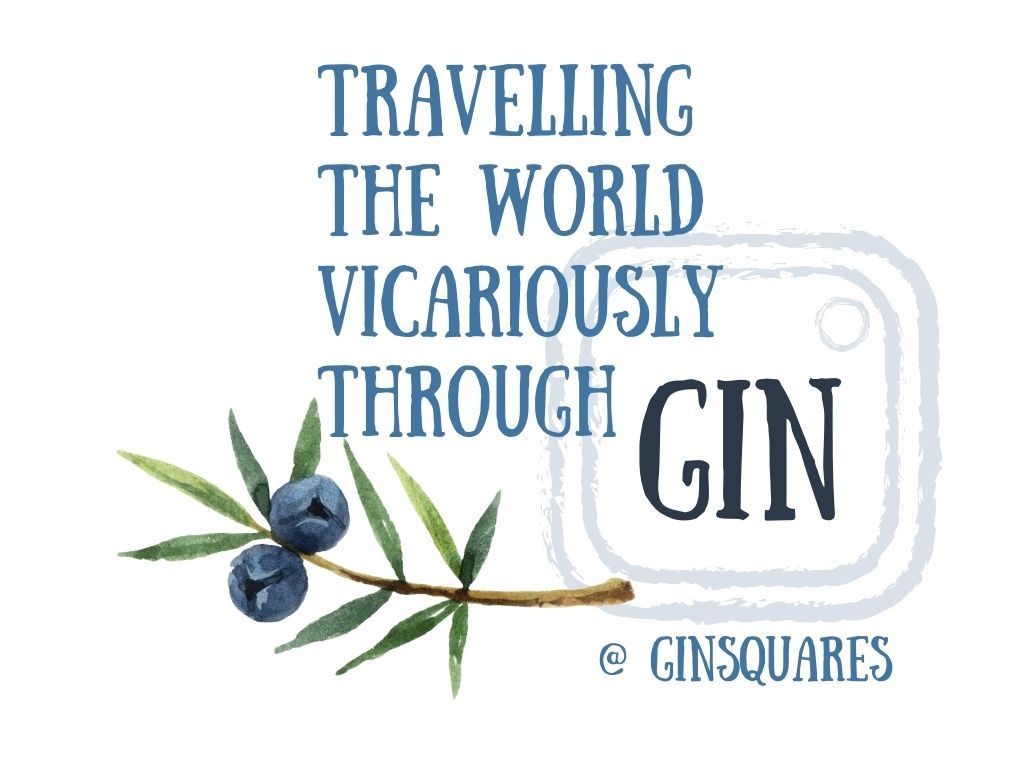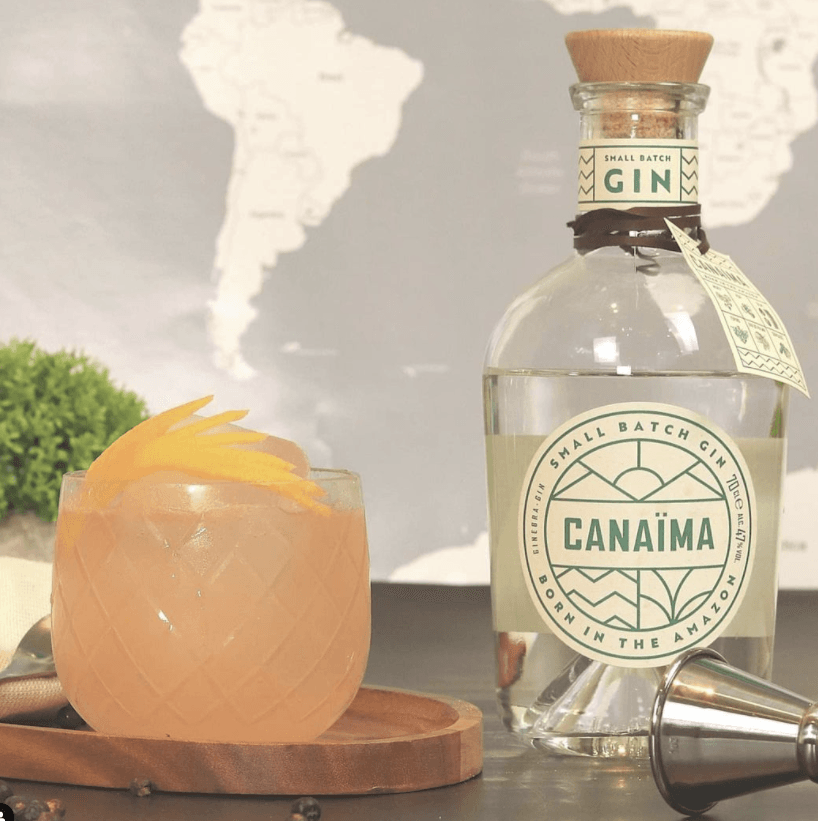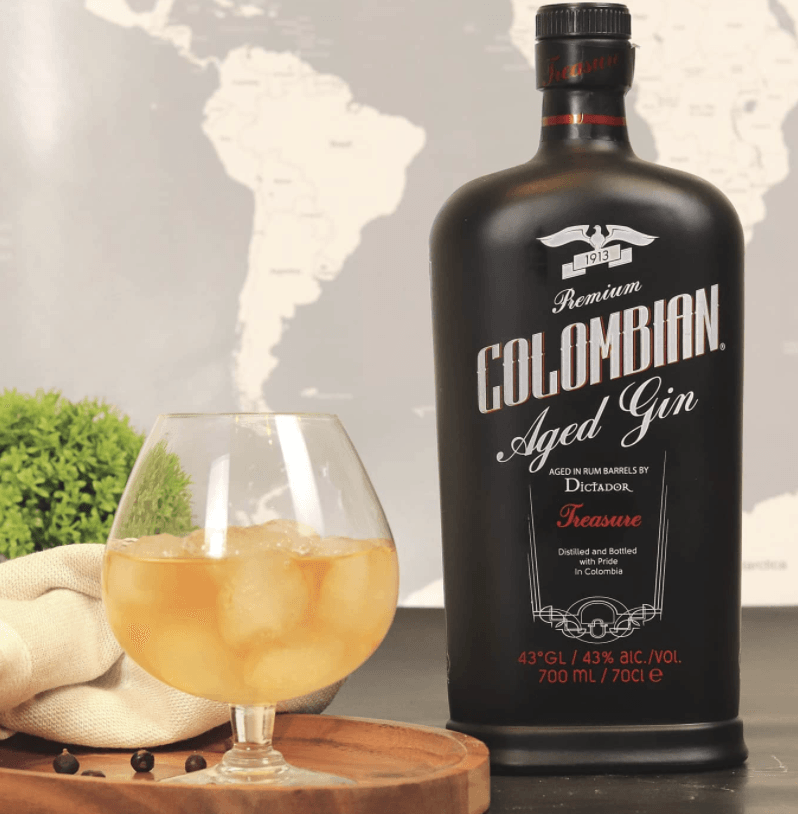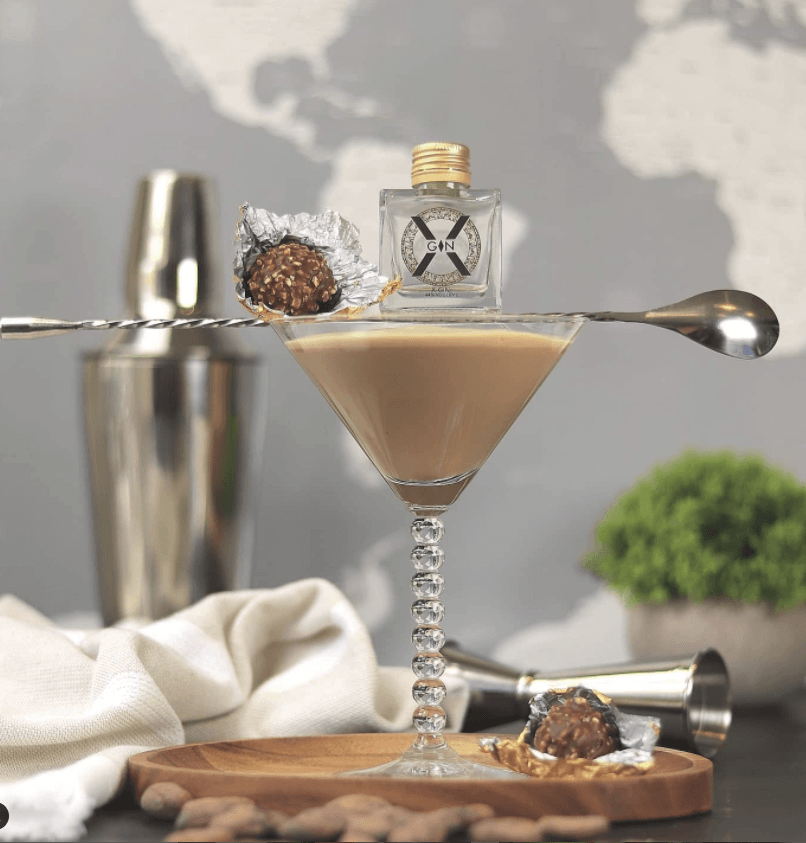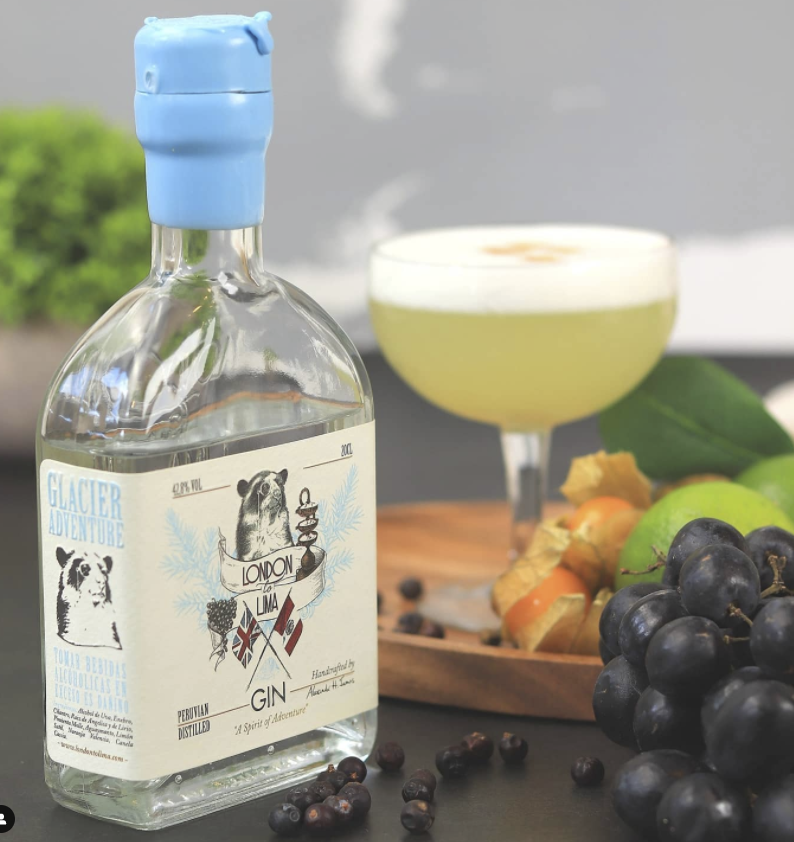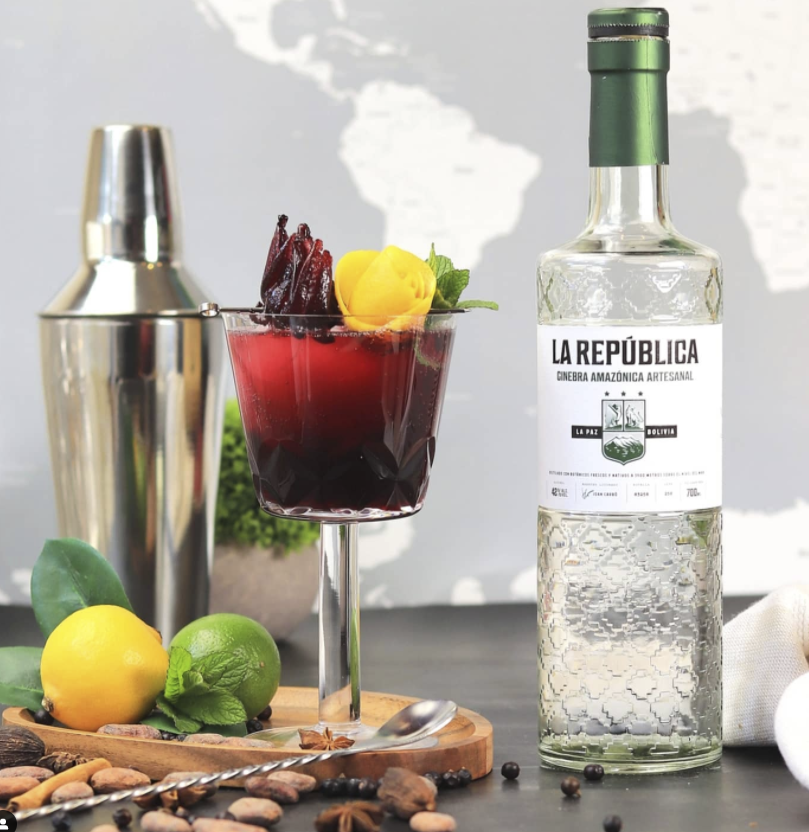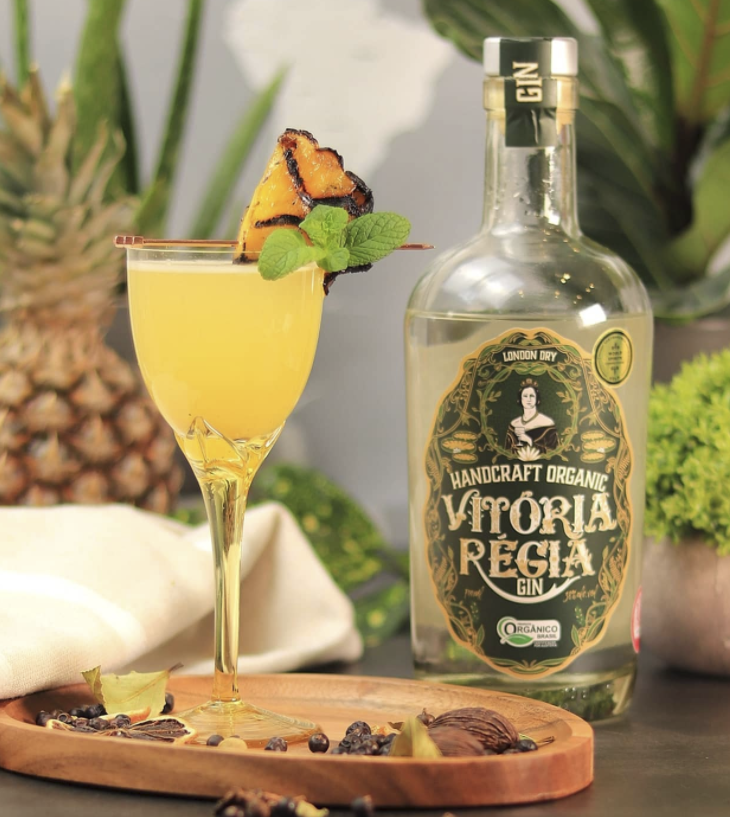SOUTH AMERICA
DAY 22 VENEZUELA
UP, UP & AWAY
I'm sure you all remember the movie Up but did you know that a lot of the inspiration and research was gathered in Venezuela. This includes the tepuis and the world's highest waterfall, Angel Falls, in the Canaima National Park, which is where Carl's house eventually comes to rest and fulfills his and his wife's lifelong dream to move their house to a cliff overlooking Paradise Falls.
Amazonia is a mysterious land which contains many legends, one of them being the Canaima. The Pemon Indians believe that this is an evil spirit, but it can take on any form, from a poisonous snake to a shapeshifting were-jaguar or mythical beast. Many pre-Colombian tribes don't believe in a natural death and so to explain death they have created this creature who pursues them throughout their lives and eventually kills them. Any mishap throughout their lives, be it a cut, bruise, stomach ache or worse, is blamed on the Canaima. Strange to name a gin after this "Spirit of Evil", but we know gin historically has quite a reputation, so I guess it's pretty fitting!
The National Park of the same name is an immense area - about the same size as Belgium - and mostly remote and inaccessible. The falls were obviously known to local people, but Auyan means devil and tepui means house in the language of the Pemon, hence the tepui from which the falls cascade, and area around it, were known as The House of the Devil and it was avoided. Visitors to the famous Angel Falls still have to make the trip by air and river. There are many stories about who was the first European to have viewed the falls - but it is named after Jimmie Angel, who flew over them in 1933 while searching for deposits of gold ore. He returned there in 1937 and tried to land atop a tepui but the ground was marshy and the plane was damaged, so he and his party had to make their way back to civilisation by foot - a journey which took 11 days. In his honour, the falls were named after him and his ashes were also spread over them. Jimmie's plane was lifted off the tepui in 1970, restored and is now on display at the airport at Cuidad Bolivar. The plane was however declared a national monument in 1964 and the federal government wants it moved back to the Aviation Museum in Maracay but the State of Bolivar apparently refuses to relinquish it!
Back to the gin though and like many other brands do, Canaima use local botanicals and work with local communities to root themselves into a specific region. They support the rainforest and offer sustainable employment for the local population, thereby creating a cause which we as consumers therefore contribute to. They use 10 botanicals sourced from the rainforest and 1 from the nearby the distillery, 8 traditional botanicals and even the label is made from previously recycled and fully biodegradable paper. As and when local botanicals are available, they are individually distilled by the team at Diplomatico Rum and then blended to create this wonderful gin. 10% of global sales goes to supporting the conservation of the Amazon. The recommended serve is grapefruit soda but I've made a Jungle Spritz with gin, grapefruit juice and topped with London Essence Peach & Jasmine Soda.
DAY 23 COLOMBIA
WHENEVER, WHEREVER
If you are wanting to experiment with aged gins, this is another one I can recommend. It's very citrus forward, so the vanilla notes are not that prominent as with other aged or rested gins. The rum barrels possibly play a role too, with the gin offering slightly sweet notes alongside a little heat, with some fresh lime notes to finish. So if you are dipping your toe into aged gins, this is definitely one to try and is perfect sipped over ice or even in a G&T.
It's distilled with a sugar cane base and aged for 35 weeks in oak barrels previously used to age Dictador Rum. The botanicals include the Colombian fruit limon mandarino, which is imparts an exotic citrus sweet taste balanced with the acidity of lemon. Juniper you ask? I don't get very strong resinous or piney notes, but we are firmly in rum territory here, so it has to be appreciated that the gin is most likely developed to local tastes and using botanicals which we in the UK are unfamiliar with and which may dominate more. I'm fine with that - I don't expect my entire international collection to taste the same and I do love that they are all so different.
Severo Arango y Ferro was dubbed El Dictador in the 18th Century, when he arrived in Colombia and had plans to improve tax collection for Spain. He very quickly fell in love with rum and became a very keen trader. In 1913 one of his descendants, Don Julio Arango y Parra, established the Destileria Colombiana, which was to become the finest Colombian rum producers in the Caribbean Zone. Now in it's third generation, the family has continued to run the company, dipping their toe into the world of gin as a result of former President of Dictador, Dario Parra, falling in love with it during his travels to the UK.
Colombia is one of the three largest sugar cane producers in the world and being based in Cartagena, Dictador is blessed with 800 miles of Caribbean Sea coastline and it also has the perfect micro-climate, ideal for aging rum. They also use sugar cane honey instead of molasses for their rum. Less than 1% of rum produced by Dictador is sold in Colombia as the government protects their own distilleries and restricts the sale of it throughout Colombia.
The walled city and fortress of Cartagena were designated a UNESCO World Heritage Site in 1984 and the beautifully preserved cobbled alleys with many bars and restaurants, make it the perfect tourist destination. During the Spanish colonial period Cartagena played a key role in administration and expansion of the Spanish empire. It was a key port of the export of Peruvian Silver at the time and even today is one of the largest ports in South America. It's arguably one of the most popular tourist attractions in Colombia, so if you aren't into rum or gin, then perhaps it's coffee and whenever, wherever, maybe you'll bump into Shakira!
DAY 24 COLOMBIA
X MARKS THE SPOT
Although this is a Belgian gin, they use Colombian cocoa beans, so I'm slotting it into my journey! It's an intriguing gin, using cocoa and vanilla in the botanical lineup. I never know if it's quite right in a G&T and eating chocolate on the side is a bit odd for me as well, as I'd rather have a savoury snack! Hence I've served up my version of an Espresso Martini, which I'm more than happy to have with chocolate on the side!
X-Gin takes it's name from an Aztec recipe for Xocoatl, said to have been an aphrodisiac and containing a hint of cocoa. It dates back about 2500-3000 years and was an essential part of Aztec culture. Xocoatl actually translates as bitter water. It was popular with Aztecs and Mayans and enjoyed either hot or cold. The recipe did not include sugar, as the Aztecs did not cultivate sugar cane, so they had no means of sweetening the bitter cocoa, although some research I did threw up the option of adding honey, which I'm sure they must have had access to. They believed cacao was given to them by the gods, using it in religious rituals but also using the beans as currency. It's claimed that it was the Spaniards who thought the drink was too "savage" and not suitable for european palates, so changed the recipe, sweetening it with sugar and adding spices like cinnamon and vanilla, but the myths and legends start much earlier than this and here is one that aligns well with our lives today.
Ixcacao was the Mayan Goddess of Chocolate and she was worshipped as a fertility goddess, but had different names and roles in the ancient cultures of Mesoamerica. She was seen as a compassionate goddess of abundance, banishing hunger and providing safety and security of the people. As time went on, large cities were established and cultures changed. She was forced to marry the God of Commerce and her cocoa beans were turned into currency and declared a food of the gods. She was saddened to see human sacrifice practiced and so she accompanied them as they climbed the steps to meet their executioner, offering them mugs of cocoa along the way. Aristocrats became lazy and Ixcacao conspired with the Goddess of Love to ferment wine and add cocoa to make it intoxicating and an aphrodisiac. There was a period of unbridled gluttony and warfare and kingdoms fell as the rulers were oblivious to this all. People were starving and were reminded that there was more to life than working for their masters. The Goddess of Love rewarded Ixcacao for her role in the downfall of the aristocracy and reinstated her as both the fertility goddess, but also the queen of love and pleasure.
X-Presso Martini
25ml X-Gin
25ml Fresh Espresso Coffee
10ml Irish Cream Liqueur
10ml Cream
10ml Frangelico
DAY 25 LIMA, PERU
LONDON TO LIMA
There is such a lovely story behind this gin, that I had to include it in my tour! It's fitting too, as it represents a tradition of adventure and sharing a passion for exploring the unknown, which is mostly what I'm doing on this virtual tour! Although most of my tour is virtual, there are a few destinations I've covered and will still cover, that I have physically visited and Peru is one of them. I'd always dreamed of hiking the Inca Trail and I'm so grateful that I had the opportunity to do that (many moons ago). Possibly the most physically difficult and emotional thing I'll ever do, but an amazing experience. But enough of that, let's get on to the story behind the gin!
The distiller Alex James, is ex-British Army, with a family history of wines and spirits. When he left the army, he was keen for a new challenge and embarked on a journey learning the art of distilling. He and his Peruvian wife Karena had bonded through shared passions, so they decided to create something that fused both their backgrounds and heritages, and this involved moving the family to Lima and of course. The gin he created when he got there was one which reflected the journey he and his family had made - London to Lima. The label on the bottle hints at this story too, including both the Union Jack and Peruvian flag. It features the Spectacled Bear, a treeclimber with a diet of gin botanicals - berries, bulbs, honey, fruits, sugarcane and palm hearts - as well as their copper pot still called Endeavour. The bottle is made from recycled glass, resembling a hip flask and on the back of the label is an expedition map (dating back to 1932) of the Cordillera Blanca, which inspired them to find the perfect water source for their gin.
The distillery is located on the coast of Peru, about an hour south of the capital Lima. The coastline is mainly desert, but this area is well irrigated and the distillery is surrounded by fruit and palm trees and many of the botanicals used are also locally grown. As hinted above, the water used is glacial meltwater and is sourced in the Andes, where Alex collects it from a remote village. The water comes from a source much higher, but he has piped the water down from the source to the village, thereby eliminating any possibility of it being contaminated along the way. The village benefits from this fresh water too and Alex regularly collects it in his jeep - a drive which takes him up to 3800m above sea level.
L2L is a grape based gin, using Quebranta grapes, which have traditionally been used to make Pisco - an unaged brandy likened to Grappa and sometimes Tequila. The Pisco base makes this a unique gin together with traditional botanicals but they also add pink peppercorn, Peruvian lime, Valencian orange, cinnamon and Peruvian Groundcherry (Physalis). This gin lends itself to many serves, but I've gone with a L2L Sour, as a nod to the Classic Peruvian Pisco Sour. Simply gin, sugar syrup, lime juice, egg white or foamer, with a dash of bitters as garnish.
DAY 26 LA PAZ, BOLIVIA
GIDDY HEIGHTS
I am loving this tour of my collection and sharing stories with you all every day. Having to cover so much ground and research so many different gins means I don't have time to connect with every brand, even though I would love to - it's just impossible, so I plod along doing my desk research! However, I am extremely grateful to Anahi at La Republica, who last week offered me an amazing zoom tour of their distillery in La Paz! I feel so privileged to have had a look around to learn more about how they do things there, and I'm now more in awe of this brand than I was before!
There are few distilleries who can claim to be the highest distillery in the world! La Paz is the world's highest capital city, sitting at a giddy 3600m above sea level, so I think it's safe to say, they probably win, but how does this affect distillation?
Altitude affects the boiling points of water and alcohol and so distillation is at a much lower temperature than at sea level. The thin air allows a much gentler distillation, using less heat, making it easier to separate (make cuts) aromatics from bad congeners, which is exactly what we want in a gin - just the hearts! We see this a lot with distillers who use vacuum distillation - when pressure lowers, the boiling point lowers. The result is more intense flavours, as the slower distillation process enhances the flavours drawn out of the botanicals and the essential oils are less stressed by the lower heat. It's also important to use a good base spirit and La Republica are very particular about their sugar cane base. This is twice distilled and rectified by 1825Vodka, who they collaborate with locally, to ensure the lowest quantities of methanol remain and even so, they still make generous cuts to ensure only the best part of the distillate is kept. They reuse the heads as cleaning products and treat the remaining tails before disposing of them. Every process is carefully considered and they control every aspect of their product - from sourcing right through to bottling and labelling, which they do themselves onsite at their distillery.
The two minds behind the first gin made using Amazonian botanicals, are Bolivian born Daniel Lonsdale and Catalonian Joan Carbó. Before they met, Daniel was working in the family business but he was unceremoniously fired by his father, Tommy Lonsdale, given their differing opinions on how to run a business and so he returned to university to complete his degree. Joan, a keen distiller and student of oenology had followed his girlfriend (a close friend of Daniel's) back to La Paz and had fallen in love with Bolivia and all the amazing botanicals. He shared with Daniel a dream to use these plants and fruits to distill unique spirits at altitude and create a tribute to this beautiful country.
It was the perfect collaboration and project for the friends to embark upon. Daniel's family had a history of producing spirits, which were distributed throughout South America, but Destileria Boliviana had to close in the 1960s due to political unrest. His grandfather, Jorge Lonsdale, actually produced some of Bolivia's first gin and whisky, but from only imported botanicals and he was also instrumental in bringing Coca Cola to Bolivia through their company, Vascal. Daniel was keen to follow in his late grandfather's footsteps, but to produce an Andean gin that would make Bolivia proud. With Joan's distilling experience and energy, as well as all their joint savings, they set about producing their first product - a spicy brandy called Supay. This impressed a friend so much, he invested in their business, Master Blends, offering them the funds to purchase their first still from Europe.
After a rocky start, with their beloved still catching fire on their first distillation, two years later in 2014, they managed to launch their first expression, Andina. This expression as the name implies, captures the essence of the Andes and uses botanicals which are local and easily sourced. Juniper is well balanced alongside the other botanicals used and is not prominent - something that Daniel is keen to point out. This ensures that the gin is distinctly different from European gin.
Inspired by the smell of the jungle and trying to replicate its atmosphere, a second expression, Amazonica was created. The botanicals for this are carefully selected from a very complex chain of suppliers, but also in the most environmentally-friendly way possible. They use 8 Amazonian botanicals and aim to support the local farmers and indigenous tribes by doing so. Included are cacao and acai, as well as bark from three different trees found only deep in the rainforest - each of which feature in local mythology and are collected and delivered to the distillery twice a year by local tribes. They just had a delivery last week and I was able to see the bark all laid out to dry, as coming from the heart of the jungle, it was understandably soaking wet! The botanicals for both expressions are macerated for 24 hours and then distilled, resulting in award-winning spirits which are full of fruity and earthy surprises.
They have two 450 litre copper stills, which use an open flame and each one is used to distill a different expression. Andina is distilled in Llama and Amazonica in Jaguar. The macerated mix of fresh and dried botanicals takes about 8 hours to distill. All botanicals apart from juniper are sourced in Bolivia and as some of the fruits are seasonal, they also have to freeze some of the pulps, so that they can distill year round.
Together with Diego Nicolini, a vineyard owner from Peru who came onboard around 2017, the business has the perfect trifecta and they have created an amazing range of spirits to date. This collaboration also benefited them a third jacketed still, which they use to double-distill a third gin expression - Master's Reserve. Their spirits include Yerbasanta vermouth and also Cocolero de Altura, which although contains juniper, is not marketed as gin and is made for Irish brand, Intrepid Spirits. They are soon to release the first Premium Bolivian Tonic Water, as well as a Soda Water, named after Daniel's grandmother - Doña Maria - and produced for them by Prost.
Their head office and distillery is in a residential area of La Paz. It's a colourful building, with beautiful graffiti artwork adorning not only on the outside wall but also in the courtyard and building. The art reflects the origins of their brand and pays homage to the Llama, Jaguar and the beautiful surrounding Cordillera Real, from which they source glacial water used in the making of their beautifully fragrant gins.
Their gin bottle is simple, yet beautiful. The pattern is not just geometric, it is a symbol of South America - the Andean Cross or Chacana. It is a compass, a calendar and the 4 main points represent the main stars in the Southern Cross. The crest is crowned with 3 stars - representing not just the 3 levels of existence but also the 3 owners. The Condor replaced the Llama in their rebranding and represents the Andes, while the Jaguar represents the Amazon - their gin expressions Andina and Amazonica. The mountains are the Cordillera Real, which I mentioned above. It's so well thought through - simple, yet says so much. Look closer to the lettering of La Republica - there's a mountain in there too. This is the stuff I love about brands - the things you don't always see at first, but when you learn about them or figure them out, they tell a story that is more powerful than words.
I was told I had to serve up the most popular cocktail they make with Amazonica - the Ginjam. It's a basic gin sour, with hibiscus infusion and topped with tonic, but I'll share the recipe in my stories.
Salut y muchas gracias Anahi!
DAY 27 BRAZIL
THREE'S COMPANY
Day 27 #virtualworldgintour
Have you spotted the third release from the Amazzoni Distillery? Maniuara Citrico is a lighter and more delicate recipe and bottled at 38%, falling into the Old Tom Category and has already won Best Brazilian Old Tom in the World Gin Awards 2021! It's named after the Maniuara ant, a spicy and citrussy delicacy of the Amazonian rainforest, used in a sacred liquid drunk during spiritual ceremonies performed by indigenous tribes and is represented by lemon and lemon grass in the botanical lineup. Together with Rio Negro, which also won Double Gold in San Francisco and the multi-award winning Amazzoni Gin, we gin lovers are certainly spoilt for choice. Unfortunately Maniuara hasn't quite reached our shores here in the UK yet, but I'm sure it eventually will.
Amazzoni, founded by friends Arturo Isola and Alexandre Mazza, is the biggest gin distillery in Latin America and given the national spirit in Brazil is cachaca, they have been instrumental in educating local consumers about gin. Their distillery founded in 2017 is located on an 18th century coffee farm about 130km south of Rio de Janeiro, the Cachoeira (which means Waterfall) Farm, and was the first gin exclusive craft gin distillery in Brazil. Pernod Ricard invested in the company a few years ago but to what extent is not disclosed or in the public domain and this has helped increase exports and open new overseas markets for them. Pernod Ricard are investing heavily in gin brands and their portfolio includes gin brands such as Seagram's, Beefeater, Plymouth, Malfy, Ki No bi, Monkey 47, Inverroche and even non alcoholic brands such as Ceder's, all of which will and have already benefitted from support accessing international markets. Amazzoni also featured as July 2020 gin of the month with @craftginclub which further boosted their visibility in the UK.
The recipe for their first gin was developed with mixologist Tato Giovannoni, using 11 botanicals, 5 which represent the 5 different regions of the Amazon - cocoa, brazil nut, maxixe (cucumber), Victoria Regia (water lily) and Cipo Cravo (carnation vine). The distiller Alexandre Mazza macerates the botanicals in a neutral grain spirit before distillation in Estrela or another of their 5 copper stills and the gin is eventually cut to strength with rainforest water. Their bottles are handmade from recycled glass following historic artisanal methods.
I've recreated one of their signature cocktails - the Tropical Gin Spritz - using gin, papaya, simple syrup and topped with soda.
DAY 28 BRAZIL
FIVE GO SOLAR
I think my sense of adventure and wanting to travel the world came from reading Enid Blyton books, so I couldn't resist the caption title for this one! If you know, you know!
The craft gin world has seen a move towards more sustainable practices and this Brazilian gin is produced using solar energy. It uses an organic sugarcane base and keeps the botanical lineup simple, using 5 carefully balanced spices and citrus - juniper, coriander, cardamom, allspice and lemon peel. It is earthy but yet bright and citrussy, with juniper coming through towards the end. It's clean and brave, making all the botanicals work together beautifully - proof that less is more and that you don't need dozens of botanicals to make a really good gin! I'd even go so far as to say this is the perfect martini gin - paying homage to it's British roots! However, it has no local identity by way of using indigenous botanicals, which is somewhat disappointing, given all the wonderful gins I've already featured from South America - all of which marry traditional and local fruits and flora in their botanical lineup.
Despite this, I'm not the only one to appreciate this gin. Vitoria Regia, won Gold in the San Francisco 2020 awards and takes its name from an Amazonian water lily that was named in honour of Queen Victoria. It is handcrafted in small batches in a copper alembic still and bottled at a slightly lower 38% ABV than most gin. The distillery is located in Taquaritinga near Sao Paulo and is 100% sustainable, using only solar energy to produce its spirits. They also have a Rose version, which includes an infusion of hibiscus, cranberry and blueberry.
I thought I would try something fruity with it, but as usual, I use what I have to hand and I'm not sure my substitutions worked that well. A drop of Holy Lama Lemongrass overpowered it slightly but if you have the time and patience, here is the original recipe!
CHURA (recipe courtesy of La Republica)
45ml Gin
45ml Lemongrass syrup (I used the tiniest drop of Holy Lama Spice Drops - Lemongrass)
45ml Pineapple Juice
Dash Lemon Juice
I was however rather proud of my garnish - a caramelised chunk of pineapple. I got this to the point it was slightly smoking and then inverted the glass over it, giving a slightly smokey effect to the cocktail. Shake up the ingredients with ice - feel free to make adjustments depending on whether you prefer a less sweet cocktail. I didn't add any sugar syrup despite the substitution and it probably lacked a balance and toning down of the lemongrass, but regardless, waste not want not - I dunked the pineapple garnish in it and did drink it all!
DAY 29 BUENOS AIRES, ARGENTINA
RESTORE OUR EARTH
Today is Earth Day - celebrated every year on 22nd April since 1970. The last year has been difficult for everyone and as we start to move back to some sort of normality, it's a good time to start to reflect on our impact on the planet and show our support for environmental protection.
The Amazon is often referred to as the lungs of the earth and over the past few days I've featured gins which use many Amazonian botanicals. Today I've made a virtual stop in Buenos Aires, at a speakeasy beneath a flower and wine shop, called Floreria Atlantico. This bar has featured as one of the top bars in the world and is owned by one of the most celebrated and talented mixologists in Latin America - Tato Giovannoni, who has created several spirits, including Principe De Los Apostoles Gin.
The botanicals in Apostoles include fresh maté leaves, eucalyptus, peppermint, pink grapefruit peel, juniper and coriander. There's a definite freshness in tasting this gin, with a soft and pleasant menthol taste and it has a very smooth mouthfeel. If you aren't familiar with maté, it's used in a popular drink in Argentina called Tereré, which is made steeping the dried leaves with other herbs in iced water. The origins of the drink are in Paraguay, but it's commonly drunk across South America.
My serve is a simple G&T with a dash of Blue Curaçao and the garnish is inspired by the amazing @gin_chiri who inspired a few of us to start cutting continents out of orange peel!
